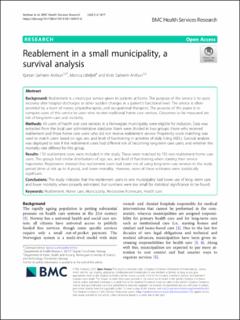| dc.contributor.author | Anthun, Kjartan Sarheim | |
| dc.contributor.author | Lillefjell, Monica | |
| dc.contributor.author | Anthun, Kirsti Sarheim | |
| dc.date.accessioned | 2021-09-21T07:07:34Z | |
| dc.date.available | 2021-09-21T07:07:34Z | |
| dc.date.created | 2021-09-01T10:53:45Z | |
| dc.date.issued | 2021 | |
| dc.identifier.citation | BMC Health Services Research. 2021, 21, . | en_US |
| dc.identifier.issn | 1472-6963 | |
| dc.identifier.uri | https://hdl.handle.net/11250/2779717 | |
| dc.description.abstract | Background
Reablement is a municipal service given to patients at home. The purpose of the service is to assist recovery after hospital discharges or other sudden changes in a patient’s functional level. The service is often provided by a team of nurses, physiotherapists, and occupational therapists. The purpose of this paper is to compare users of this service to users who receive traditional home care services. Outcomes to be measured are risk of long-term care and mortality.
Methods
All users of health and care services in a Norwegian municipality were eligible for inclusion. Data was extracted from the local user administrative database. Users were divided in two groups: those who received reablement and those home care users who did not receive reablement service. Propensity score matching was used to match users based on age, sex, and level of functioning in activities of daily living (ADL). Survival analysis was deployed to test if the reablement users had different risk of becoming long-term care users, and whether the mortality rate differed for this group.
Results
153 reablement users were included in the study. These were matched to 153 non-reablement home care users. The groups had similar distributions of age, sex, and level of functioning when starting their service trajectories. Regressions showed that reablement users had lower risk of using long-term care services in the study period (time at risk up to 4 years), and lower mortality. However, none of these estimates were statistically significant.
Conclusions
The study indicates that the reablement users in one municipality had lower use of long -term care and lower mortality when properly estimated, but numbers were too small for statistical significance to be found. | en_US |
| dc.language.iso | eng | en_US |
| dc.publisher | BioMed Central Ltd. | en_US |
| dc.rights | Navngivelse 4.0 Internasjonal | * |
| dc.rights.uri | http://creativecommons.org/licenses/by/4.0/deed.no | * |
| dc.title | Reablement in a small municipality, a survival analysis | en_US |
| dc.type | Peer reviewed | en_US |
| dc.type | Journal article | en_US |
| dc.description.version | publishedVersion | en_US |
| dc.source.volume | 21 | en_US |
| dc.source.journal | BMC Health Services Research | en_US |
| dc.identifier.doi | 10.1186/s12913-021-06910-6 | |
| dc.identifier.cristin | 1930368 | |
| dc.relation.project | Regionale forskningsfond Midt-Norge: 284985 | en_US |
| dc.source.articlenumber | 877 | en_US |
| cristin.ispublished | true | |
| cristin.fulltext | original | |
| cristin.qualitycode | 2 | |

